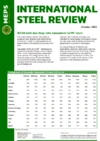Steel plays key role in Taiwan’s earthquake resilience
Taiwan’s steel industry may play a key role in the country’s recovery after being central to its resilience to this week’s 7.4 magnitude earthquake.
MEPS respondents reported minimal disruption to the country’s steelmaking operations, which are located on the country’s west coast, following Wednesday (April 3) morning’s destructive tremors.
Steel will now play a key role in the reconstruction of earthquake affected areas following the success of strict building regulations which saved lives as Taiwan suffered its most severe earthquake for 25 years.
Limited impact on steel supply
Taiwan’s major steelmakers, including China Steel Corporation, Tung Ho Steel and Yieh United Steel, are located well away from the earthquake’s epicentre Hualien.
The Taiwan International Ports Corporation reported terminal damage at Hualien’s port – suspending operations there – but confirmed that no other Taiwanese ports suffered substantial damage. The main cargos which pass through Hualien Port are gravel, stones, cement, bamboo, sugar, and lumber.
Consequently, MEPS respondents indicated that there would be very little disruption to steel supply. Nonetheless, MEPS steel market analyst Chris Jackson said: "Participants, not just in Taiwan, but East Asia as a whole, have had to contend with low booking activity, high inventories and - as an export-led economy - a reduced inability to ship the quantities they would like to traditional export markets, due to weak demand in Europe and North America.
“The recent events in Taiwan will do little to boost market sentiment.”
Worldsteel data showed that Taiwan’s 2023 crude steel output declined 8.9% year-on-year to 18.9 million tonnes. Meanwhile, according to data from Taiwan’s Ministry of Finance the value of Taiwan’s steel export declined by 24.4%, to USD17.1 billion last year.
Steel’s role in Taiwanese construction
Some increased demand may result from the requirements of the country’s rebuilding efforts following this week’s earthquake.
Taiwan’s government significantly tightened its building regulations and invested heavily to retrofit buildings with structural steel and reinforced concrete after a 7.6 magnitude earthquake, in September 1999, caused 2,400 deaths and 100,000 injuries.
This week’s earthquake highlighted the success of those actions and construction experts suggest that the subsequent rebuild, and ongoing efforts to upgrade older buildings, will require greater volumes of steel.
To date, 12 people are known to have died, and 1,000 suffered injuries, as a result of this week’s earthquake. Taiwan’s reinforced buildings, which remained structurally intact despite significant movements, saved lives.
In February last year, more than 53,000 people were killed in Turkey and over 5,000 died in northern Syria in a series of three major earthquakes which registered magnitudes of 7.8, 7.5 and 6.4. At least 37,066 buildings collapsed and 200,000 were heavily damaged in those events.
- Monthly insight on the Taiwan's carbon steel market is published in MEPS's International Steel Review. The country's stainless steel market is also covered in the Stainless Steel Review. These monthly reports provide subscribers with steel prices, indices, market commentary and forecasts from key steel markets across the globe.

Source:
International Steel Review
The MEPS International Steel Review is an essential monthly publication, offering professional analysis and insight into carbon steel prices around the world.
Go to productRequest a free publication





